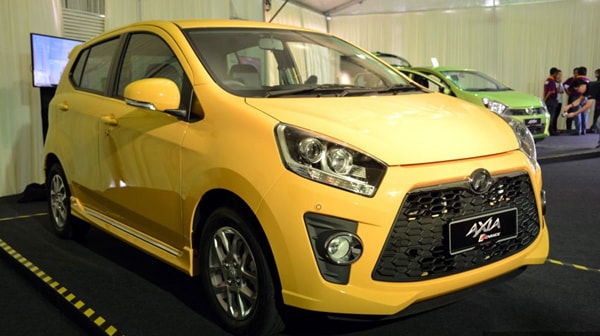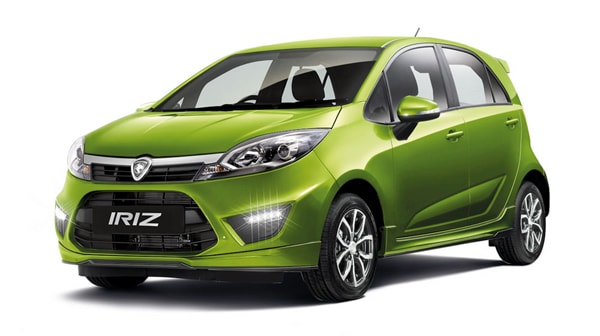Amidst the cheap car siege, Vietnamese people should not be delusional.
Vietnam is surrounded by factories producing cheap cars. From Thailand, Indonesia, Malaysia, dozens of cheap car models are waiting for the opportunity to penetrate the Vietnamese market.
Cheap cars surround
Malaysian car manufacturers have begun jumping into the low-cost car segment race, with the consecutive launch of two car models priced from 7,700 USD and 13,000 USD within the past month.
Specifically, car manufacturer Proton has just officially introduced the Iriz hatchback model to the Malaysian market. Participating in the B-class car segment, Proton Iriz is equipped with new generation VVT engine technology with 2 versions 1.3L and 1.6L. The company has now started taking orders for Iriz, with prices ranging from 13,000 USD (standard version) to 19,300 USD (premium version).
A month earlier, Perodua also introduced the fuel-efficient vehicle (EEV) Axia in the Malaysian market, priced from 7,700 USD (equivalent to about 162 million VND), a dream number for Vietnamese consumers.
 |
 |
Based on the Daihatsu Ayla sold in Indonesia, the Perodua Axia uses a 1.0L engine with a 5-speed manual or 4-speed automatic transmission. The car is sold in the Malaysian market in 4 versions, priced from 7,700 to 13,000 USD.
In Indonesia, manufacturers have launched a series of low-cost car models. Daihatsu soon launched the small car Ayla with a 1.2L engine, which has a fairly cheap price, the standard version is only 6,600 USD equivalent to 120 million VND. Soon after, Toyota also launched the small car Agya, equivalent in size to the Chevrolet Spark, Hyundai i10 and Kia Morning models. Toyota Agya uses a 1.0L 3-cylinder engine, combined with a 5-speed manual transmission or a 4-speed automatic transmission. Toyota Agya's selling price ranges from 7,900-11,000 USD (equivalent to 160-240 million VND).
At the end of 2013, Nissan also chose Indonesia to launch the March 2014 model with a 1.5L engine. This is a competitor to cheap small cars such as Honda Jazz, Toyota Yaris and Ford Fiesta in the Southeast Asian market. March 2014 has a starting price of 13,537 USD, equivalent to about 270 million VND.
In Thailand, a series of low-cost car models have been launched recently. Suzuki launched the Swift with a 1.4L engine, priced at 15,000 USD. Mitsubishi launched the Mirage with a 1.2L engine, priced from 11,000-13,000 USD. Most recently, Honda launched the Brio with a 1.2L engine, 90 horsepower, priced at 13,000 USD. Not only is it cheap, the Honda Brio also impresses with its full standard safety equipment such as airbags, ABS brakes and EBD.
Hard to get cheap prices
Certainly, the launch of cheap products is not only for consumption in the Thai, Malaysian or Indonesian markets, but manufacturers are also aiming at the Southeast Asian market in general, including Vietnam. According to the roadmap to join AFTA, by 2018, the import tax rate on cars from ASEAN countries will be reduced to 0%, at which time many car models will flood into Vietnam.
 |
| ASEAN countries are massively producing cheap cars, but when they arrive in Vietnam, the prices can double. |
Vietnam is considered a potential automobile market in Southeast Asia, with a population of nearly 100 million people and an increasingly developing economic life. It is predicted that after 2020, when the average income per capita increases to 3,000 USD, the automobile market will explode. Therefore, manufacturers never miss this opportunity.
Manufacturers have now decided to locate their factories in the countries that are most profitable for them. Vietnam is considered an unattractive destination, so many car manufacturers do not invest in it, and even consider leaving Vietnam for other countries.
Mr. Sukurada Yoichi, senior researcher at Mitsubishi Research Institute (Japan), recently said that some Japanese enterprises are considering moving from Vietnam to Thailand when the import tax rate for cars in ASEAN is reduced to 0%. At that time, Vietnam will become a market for cars from ASEAN countries.
However, imported cars to Vietnam will hardly be cheap. In addition to high taxes and fees, the main planners are proposing to build non-tariff barriers such as tightening vehicle inspection, limiting seaports for car imports, requiring strict standards for distributors, raising tax prices... If these measures are applied, it is difficult to hope for car prices to decrease.
Not only that, many businesses will not want to reduce prices to gain profits. Take for example the Suzuki Swift model, which in Thailand is priced at 15,000 USD, equivalent to 300 million VND, but when imported to Vietnam, the price is up to 560 million VND.
When Suzuki assembled this model in Vietnam, even though the import tax rate for the components was only 25%, half of the import tax for the complete car, its selling price was only 10 million VND lower than the imported car. Not only that, some details were also cut compared to the imported version such as airbags, fabric seats instead of leather, and rear drum brakes.
Certainly, cars from ASEAN countries will flood into Vietnam, but the expected low prices are not certain.
According to Vietnamnet

.png)






